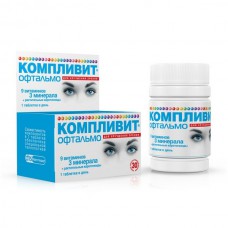Expiration date: 04/2025
Release form and composition:
Tablets, film-coated from pinkish-orange to orange, round, lenticular, with a characteristic odor.
1 tablet contains:
retinol acetate (Vit. A) 1 mg (2907 IU)
apha-tocopherol acetate (Vit. E) 15 mg
ascorbic acid (Vit. C) 50 mg
thiamine hydrochloride (Vit. B1) 5 mg
Riboflavin (Vit. B2) 2 mg
pyridoxine hydrochloride (Vit. B6) 5 mg
folic acid (Vit. Bc) 400 mcg
cyanocobalamin (Vit. B12) 3 mcg
rutin (rutin) (Vit. P) 25 mg
copper (sulfate pentahydrate) 1 mg
zinc (in the form of oxide) 5 mg
selenium (sodium Selenite) 25 mcg
zeaxanthin (opticare) 1 mg
lutein 2.5 mg
Excipients: talc, potato starch, citric acid, ludipress (lactose monohydrate, povidone, crospovidone), low molecular weight povidone (polyvinylpyrrolidone low molecular weight), magnesium stearate, sucrose (sugar), D-sorbitol (sorbitol food grade), sodium carmellose (vimasol).
The composition of the shell: hyprolose (hydroxypropyl cellulose), macrogol (polyethylene glycol), low molecular weight povidone (polyvinylpyrrolidone low molecular weight), titanium dioxide (E171), talc, colorant sunset yellow (E110).
30 PCs banks polymer (1) - packs of cardboard.
60 PCs banks polymer (1) - packs of cardboard.
90 PCs banks polymer (1) - packs of cardboard.
100 PCs banks polymer (1) - packs of cardboard.
120 PCs banks polymer (1) - packs of cardboard.
Pharmacological action:
Combined preparation containing a complex of vitamins, minerals, and plant carotenoids.
Pharmacological action of the drug due to the properties of its constituent components.
The compatibility of components in 1 pill is provided for vitamin preparations production technology.
Ascorbic acid (vitamin C) - regulates capillary permeability and plays an important role in the preservation of their elasticity. Activates the activity of the endocrine glands, regulates blood clotting, tissue regeneration, education steroid hormones, collagen synthesis. Has a stimulating effect on the organism as a whole, increases its adaptive capacity, resistance to infections and adverse effects.
Thiamine (vitamin B1) - involved in the process of impulse transmission along the nerve fiber. Involved in coordinating the functioning of the nervous, cardiovascular and endocrine systems. Plays a key role in ensuring the normal course of energy metabolism.
Riboflavin (vitamin B2) is involved in carbohydrate, protein and fat exchanges in the synthesis of hemoglobin and erythropoietin. Essential for maintaining normal visual function.
Pyridoxine (vitamin B6) as a coenzyme participates in the metabolism of amino acids and carbohydrates. Ensures the normal functioning of the Central and peripheral nervous system.
Folic acid (vitamin BC) - in the form of coenzyme involved in various metabolic processes, necessary for the synthesis of nucleic acids. Has Antianemic action.
Cyanocobalamin (vitamin B12) is involved in the synthesis of nucleotides is an important factor in hematopoiesis and normal growth of epithelial cells is essential for the metabolism of folic acid and myelin synthesis.
Rutin (rutin, vitamin P) - participates in redox processes, has antioxidant properties, prevents oxidation and promotes the deposition of ascorbic acid in the tissues. Strengthens capillary walls by regulating their permeability. Reduces swelling and inflammation, strengthens the vascular wall.
Retinol (vitamin A) is an integral part of the visual pigment rhodopsin is essential in maintaining eye function, ensuring normal activity of the visual analyzer and the perception of the eye light. Effective in night blindness (night blindness), diseases of the retina and cornea. Involved in the regeneration processes of the skin and mucous membranes.
apha tocopherol acetate (vitamin E) has antioxidant properties, maintains the stability of the red blood cells has a positive effect on gonadal function, nervous and muscular tissue. Participates in the processes of tissue respiration, affects the function of the endocrine glands, slows the aging process of the tissues of the body.
Lutein and zeaxanthin - carotenoids, yellow pigments, necessary for normal functioning of the retina. Protect the eyes from damage caused by exposure to ultraviolet light. Are components of the antioxidant system of the retina, one of the most important factors of eye protection. Located in lens and retina lutein and zeaxanthin protect photoreceptors cells from oxygen radicals, resulting in adverse effects on the eye of radiation of different origin. The low content of lutein and zeaxanthin in eye tissues leads to weakening the ability of the eye to resist the unfavorable factors, long-term visual stress, computer radiation.
Selenium - a natural antioxidant, improves the immune system. In combination with vitamins a, E and C has a strong antioxidant effect, improves the adaptive capacity of the organism in the conditions of influence of adverse factors (stress, Smoking, pollution).
Copper is a catalyst in many biochemical reactions. Involved in the synthesis of melanin. Plays a significant role in the formation of collagen and elastin is an essential component of iron metabolism, plays an important role in the process of hematopoiesis.
Zinc - promotes the utilization of vitamin A the retina. Prevents the development of night blindness (night blindness). Zinc is essential for synthesis of insulin, hormones of the sex glands, necessary for the normal activity of lymphoid tissue. Zinc deficiency is associated with the development of retrobulbar neuritis, blepharitis, decreased vision, cataract formation.
As a result, the drug provides a balanced flow components necessary to maintain optimum functioning of the body, has ophthalmophlebotomy effect due to the combined effect of its constituent vitamins, minerals and carotenoids, improves vision at high visual loads, has an antioxidant effect (protects eye tissue from free radical damage). May be recommended when wearing contact lenses because it contains the components necessary for tissue regeneration, including and corneal, damage contact lenses which always occurs in varying degrees.
Pharmacokinetics:
Data on the pharmacokinetics of the drug Complivit® Ophtalmo do not exist.
Indications:
- prevention of deficiency of vitamins and minerals
- syndrome of visual fatigue (the fatigue and pain in the eyes) when reading, working on computer, wearing contact lenses violations of twilight vision.
Dosing regimen:
Complivit® Ophtalmo assign into adults and 1 tablet. 1 time/day. Course duration - 3 months. The need for repeated courses the doctor decides individually.
The drug is taken after eating, squeezed enough liquid.
Side effects:
Perhaps: allergic reactions.
Contraindications:
- pregnancy
- lactation
- children up to age 18 years
- hypersensitivity to the drug.
Pregnancy and lactation:
The drug is contraindicated during pregnancy and lactation (breastfeeding).
Special instructions:
- It is not recommended to exceed the recommended dose.
- In applying the drug may staining of urine in an intense yellow color, due to the presence of Riboflavin in the composition of the drug and has no clinical significance.
Overdose:
In case of overdose the patient should seek medical attention.
Treatment: activated carbon inside, gastric lavage if necessary, - symptomatic therapy.
Drug interactions:
Not recommended simultaneous reception with other multivitamin complexes, containing vitamins A and E, vitamins of group B.
Terms and conditions of storage:
The drug should be stored out of reach of children, dry, protected from light place at temperature not exceeding 25°C. shelf Life - 2 years.



